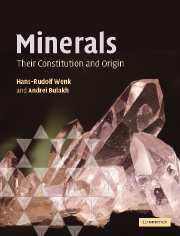Book contents
- Frontmatter
- Contents
- Preface
- Acknowledgments
- Figure credits
- Part I Structural features of minerals
- Part II Physical investigation of minerals
- 7 Experimental studies of crystal structures. X-ray diffraction
- 8 Physical properties
- 9 Optical properties
- 10 Identification of minerals with the petrographic microscope
- 11 Color
- 12 Additional analytical methods
- 13 Mechanical properties and deformation
- Part III Variety of minerals and mineral-forming processes
- Part IV A systematic look at mineral groups
- Part V Applied mineralogy
- Appendices
- Glossary
- References
- Index
- Plate section
- References
8 - Physical properties
from Part II - Physical investigation of minerals
- Frontmatter
- Contents
- Preface
- Acknowledgments
- Figure credits
- Part I Structural features of minerals
- Part II Physical investigation of minerals
- 7 Experimental studies of crystal structures. X-ray diffraction
- 8 Physical properties
- 9 Optical properties
- 10 Identification of minerals with the petrographic microscope
- 11 Color
- 12 Additional analytical methods
- 13 Mechanical properties and deformation
- Part III Variety of minerals and mineral-forming processes
- Part IV A systematic look at mineral groups
- Part V Applied mineralogy
- Appendices
- Glossary
- References
- Index
- Plate section
- References
Summary
Vectors and tensors: General issues
In this chapter we discuss some physical properties of crystals. The physical properties of minerals are as relevant as their chemical composition, but the former have been neglected in introductory mineralogy texts. The reason for this is their complexity because, in contrast to chemical composition, many properties cannot be described by simple numbers. Physical properties are intricately linked to the structure and the symmetry of crystals. Many properties are anisotropic, i.e., they are different if the crystal is rotated (from the Greek α νισος (anisos) meaning “not the same” and τρέπειν (trepein) meaning “turn”) and thus are directional. In this chapter we are not attempting to give a comprehensive coverage, but are trying to raise a few important issues to give you the flavor of basic concepts and to prepare for entering more advanced treatments. With interest in the earth's interior, mineral physics is a rapidly growing field of mineralogy. The subjects of thermal expansion and elastic properties are essential in understanding the equation of state and stability of minerals at high pressure and temperature. Anisotropic properties such as elastic and magnetic properties are of great importance in seismology in investigating the structure of the deep earth and for the paleomagnetic reconstruction of continental movements. But they are not only of academic interest: prospecting for mineral resources as well as for oil and gas is increasingly based on physical rather than chemical methods.
- Type
- Chapter
- Information
- MineralsTheir Constitution and Origin, pp. 134 - 155Publisher: Cambridge University PressPrint publication year: 2004
References
- 1
- Cited by



